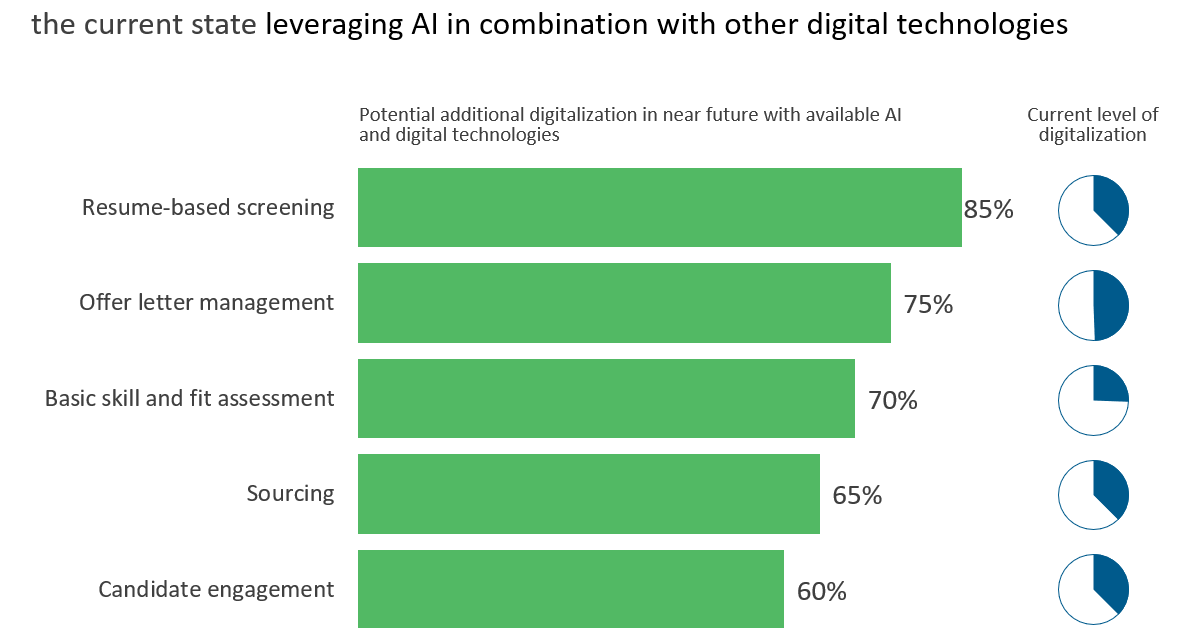Evolving Role of Artificial Intelligence (AI) in Transforming Talent Acquisition
In recent years, talent shortage has emerged as the major issue plaguing enterprises globally. According to a recent Enterprise Key Issues Survey conducted by Everest Group, talent/skill shortage is one of the top three key issues over which enterprises are losing sleep. Talent acquisition departments and their practices are under increased scrutiny as talent shortage hampers innovation, delays project implementations and adversely affects customer service. Enterprises have realized that the current talent environment warrants a strategic talent acquisition approach oriented around relationship building and candidate engagement. However, recruiters face an uphill task in following this new approach as close to 35% of their work hours are spent on transactional activities including resume screening, interview scheduling, and other pre-selection tasks.
What enterprises need is an effective instrument to take care of all these transactional tasks and free the recruiters to tackle the strategic ones discussed above. Luckily, they have found one in Artificial Intelligence (AI). AI has the potential to completely rewrite the recruitment playbook and what recruiting “looks like.” This promise of AI is luring enterprises to investigate this market disruptor, and some have even taken the next step of implementing it in their recruitment function. In a recent enterprise survey conducted by Everest Group, almost 62% of the participants responded that they are either evaluating the use of AI or are currently leveraging AI in their recruitment processes.

The core benefits that enterprises implementing AI are seeking are around cost-reduction, enhanced efficiency and actionable insights. While these are significant benefits, enterprises are looking at them in silos. This limits the potential impact of AI, which can be huge, if implemented holistically across the recruitment value chain through a well thought out strategic plan.
Enterprises need to look at the potential of AI through two key lenses – what can be achieved with the current maturity of AI technology in the near term and the expectations from AI in the long term as the technology matures and buyers become more comfortable with the concept and use of AI in their recruitment processes.
In the first scenario, with the current maturity of AI and other digital technologies, there is potential to digitalize close to 50% of all talent acquisition processes that are currently performed manually. The exhibit below shows the extent of digitalization in high potential processes that can be achieved, from the existing state, by leveraging AI in combination with other digital technologies.
Harvey balls depict current level of digitalization; Bar graph depicts potential additional digitalization in near future with available AI and digital technologies

Enterprises can use the above insights to plan their AI adoption journey to get the best return on their investments.
In the longer-term scenario, where AI technology is more mature and enterprises are already leveraging AI extensively across their transactional recruitment tasks, AI’s real potential is expected to be unleashed as an enabler for strategic decision making.
Here are the key areas where AI holds exciting possibilities.
• Predictive/Prescriptive analytics: Moving beyond reporting and what has historically happened, AI will be able to help predict what is going to happen and recommend a suggested course of action. For example, by leveraging historical enterprise data and external market data (talent availability, etc.) the solution forecasts the type and volume of workforce required in the short, medium, and long terms
• Sourcing strategy: Analyzing the channels through which some of the best performing employees are coming – e.g., through targeted email campaigns, or from specific job portals, companies, social platforms, etc. – and then specifically and preferentially sourcing from those channels using programmatic job advertising
• Personalized chatbots: Leveraging machine learning to analyze information a candidate previously shared – e.g., interests and hobbies – to create personalized content and proactively drive conversations going forward
• Real-time sentiment analysis and resolution: Gauging market sentiment on employer brand by parsing comments on social media handles, and proactively addressing any concerns prevailing in the marketplace, all with minimal human intervention
AI certainly can’t, and never will, replace hiring managers, as finding the ideal candidate is a combination of art and science. But it can certainly assume a lot of responsibilities that talent acquisition leaders and their teams are currently handling. The combination of AI and humans will deliver superior value and an enhanced experience for all stakeholders.
-min.png)



